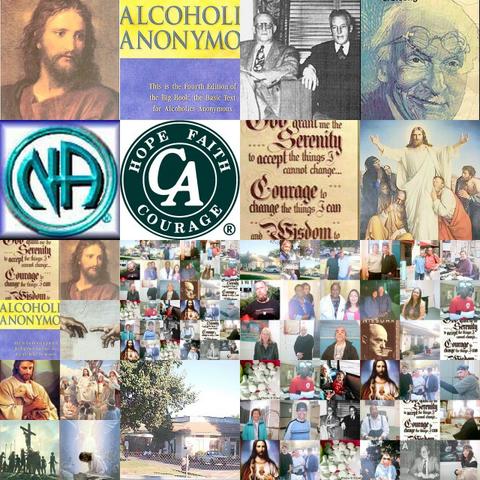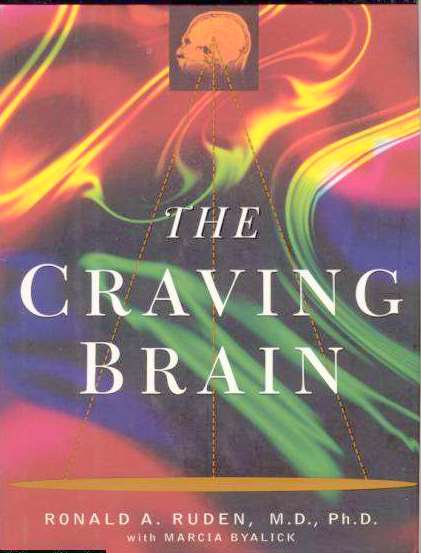The Craving Brain: The Biobalance Approach to Controlling Addiction,
by Dr. Ronald A. Ruden, with Marcia Byalick
ISBN 0060186984
The mystery of alcoholism and addiction is one that has plagued us for years. Is it a disease? Is it a choice? Physiological or psychological? Experts and researchers have published various theories and thoughts on the subject, some easier to understand and digest than others. Those of us seeking answers to these questions are left to consider all possibilities and draw our own conclusions based on personal opinions and experiences. In Dr. Ronald A. Ruden's book "The Craving Brain," the scientific theory of biobalance is introduced as a key to understanding and treating substance abuse. Applying scientific explanations to the questions of addiction and alcoholism is nothing new. But Ruden is able to break his theory down and present medical and scientific concepts in a simple, non-threatening style. We're still left to draw our own conclusions on the issues, but Ruden gives us something attainable and cogent to mull over.
The title of the book comes from Ruden's handle for what society has historically referred to as alcoholism and addiction. He says these are "craving disorders" of the brain, caused by a "craving response" to life experiences and environment. A craving brain is a brain chemically out of balance, and the solution is to put it back into balance, or "biobalance." Along with alcohol and drug abuse, Ruden applies his theory to all addictions, including overeating, gambling and sex.
In the first section of the book, Ruden examines the brain and how this complicated organ works. The author keeps his explanations clear and palatable. He starts with defining survival instincts as they apply to the human brain, and goes on to describe how and why the brain releases certain chemicals, or neurotransmitters, to accommodate our human urges and needs. The two main chemicals Ruden refers to are dopamine and serotonin. He says these two work together to both regulate our urges and satisfy our needs.
Ruden goes on to explain his theory of where addictive behavior comes from. Depending on our early experiences, and the god-given layout of our brain, the neurotransmitters may not release correctly, and what is normally a self-regulating system is now disrupted. This could happen for any number of reasons, but the author cites experiencing "inescapable stress" for a prolonged period of time as one possibility. In this case, the landscape of the brain has been altered, sometimes permanently, and cannot balance itself. The person is now left to balance his or her brain manually, i.e. with substances or behaviors that stimulate the neurotransmitters.
If all of this sounds confusing, trust that Ruden does an excellent job of presenting these theories in a graspable, step-by-step manner. The author also uses bold type for words and phrases that may need further explanation, and he includes a glossary in the back of the book.
With his theory now uncovered, Ruden explains that an addict's craving response, the abuse of a substance or behavior, becomes the automatic response. This, he says, accounts for the "I can't stop myself" feelings most addicts experience. According to Ruden, if our brain landscape is severely primed for craving, no social or moral constraints will stop us. But the author makes it clear that once we understand these responses, and understand the landscape of the craving brain, we can then learn to balance the brain (biobalance) by adopting healthy, serotonin-boosting habits.
Ruden offers several methods for arresting the craving response. He gives brief explanations of ideas behind Buddhism, 12 step programs, rehabilitation centers, and drug therapy. Ruden says each of these possible solutions can offer the craving brain a new method of producing the correct amount of serotonin to interact with dopamine and achieve biobalance. According to the author, the brain is a primitive system designed to ensure survival. One of the ancient survival instincts humans are known to possess is the need to "herd," or come together with a close community of people for comfort, safety and support. Support groups, or "herding," can produce the needed chemicals for biobalance. Similarly, this can be achieved through the Buddhist approach of liberation from the self and from desire, and other spiritual teachings. Ruden also mentions service to others as a means of boosting good feelings and balancing the brain.
The section on drug therapy in treating the craving response is the one troubled section of this book. Ruden includes information on the now illegal diet drug Fen-Phen, along with personal accounts from food addicts who have used it. This was obviously published before the dangers of the drug were publicized. Ruden also quickly glosses over antidepressants, and addiction-specific drugs such as Antabuse, Naltrexone, and Methadone. But compared to the rest of the work, this section falls short in facts and explanations.
The final section of the book includes an extended bibliography that not only cites Ruden's sources, but also "offers (the) reader a glimpse into the scientific process and explanations that led to this new understanding."
Overall, Ruden's work makes an impressive argument for the physiological rationale behind alcoholism and other addictions. His thoughts are organized and clear. The work is peppered with personal accounts from addicts, which helps take the edge off the scientific nature of the book and adds some personality to the work. Throughout his theorizing, Ruden maintains that no one method of achieving biobalance is the right method, but that there is hope for every person with a craving brain to find a solution that will work. With a simplified presentation of his theory and a realistic opinion on how to achieve recovery, this book is an enjoyable, thought-provoking read.
<>+<>+<>+<>+<>+<>+<>+<>+<>+<>+<>+<>
http://groups.yahoo.com/group/CASA-12-Steps/


No comments:
Post a Comment
Please give feedback with respect!